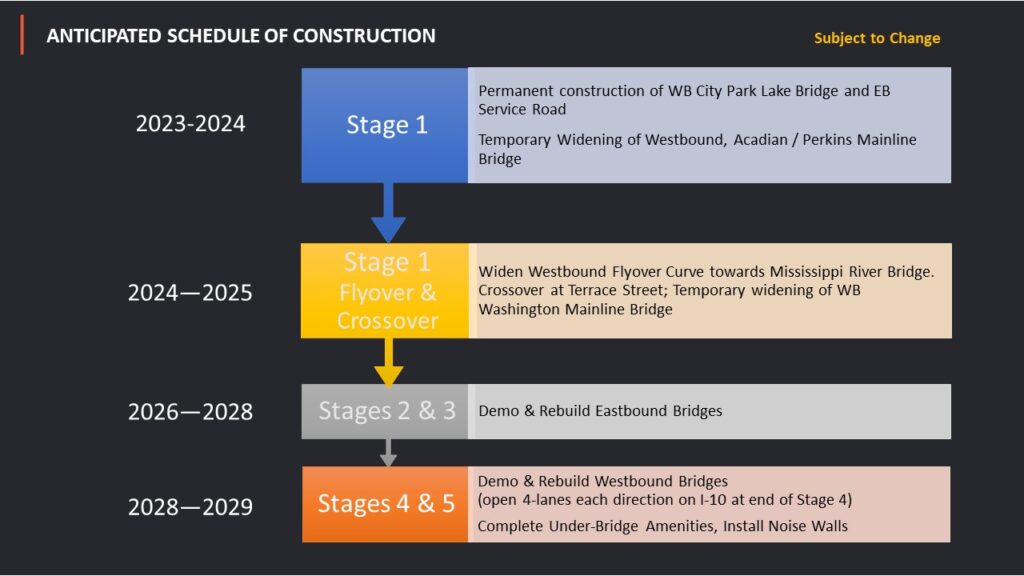Project Info
The project has now progressed from study to implementation. Once completed, there will be four travel lanes in each direction from the I-10/I-110 split to Acadian. Construction began in 2023 with utility relocation and related right-of-way work. The contractor publishes monthly project update e-newsletters accessible from the links below, and by subscribing on the homepage.
Monthly Public Outreach and Communications Report
Project Schedule
The Construction Phase Timeline provided below applies to the extended Segment 1 area and includes the widening of the I-10 westbound curve at I-110. This timeline was updated December 5, 2023 to incorporate adjustments based in part on responses to public engagement efforts. Within an overall 6-year construction duration, addition of a temporary westbound lane is beginning in late 2023 with additional traffic mitigation work continuing through 2025. Stage 2 – the demolition of eastbound I-10 bridges – is anticipated to begin in 2026.
Community Connections
The U.S. Department of Transportation Federal Highway Administration has developed and adopted a series of guiding principles and toolbox of techniques for identifying and deploying transportation innovations, partnerships and technologies to bring communities together, and to connect people to services and opportunities. During the feasibility and Environmental Assessment stages of the project, a number of Context Sensitive Solutions were identified in dialogue with project stakeholders and community groups. These proposed physical improvements, documented in the reports and specifically in the FONSI linked below, are commitments by DOTD to the community as the I-10 widening project moves forward. The extended Segment 1 corridor contains four of these CSS improvements:
- The I-10 greenway will be a pedestrian and bicycle path which will link the existing downtown greenway network to the soon to be improved (through a separate project) bicycle and pedestrian pathways around the University Lakes.
- Noise Walls will line the widened interstate through the corridor. Preference polling of options for noise wall panel materials and designs are being offered.
- The new I-10 bridge spanning City Park Lake will feature aesthetic treatments to improve its appearance from local surface streets and monument towers to signal to interstate motorists they have “arrived” in Baton Rouge.
- Perkins Road Corridor Improvements will include better public parking for businesses, more and better safety lighting, multi-modal transportation improvements such as a better connected local street grid, pedestrian walkways and bicycle accommodations. Note public open house on May 19, 2022!
Public engagement activities began in late 2021 focused on the I-10 greenway corridor with adjoining neighborhoods of Old South Baton Rouge. Progress has been made to prioritize desired greenway amenities, determine their location(s), and DOTD has been initiating partnerships with local government and nonprofit agencies to secure maintenance agreements for all enhancements provided through the project. Additional community and stakeholder meetings will occur in 2022 to further refine proposed greenway designs.
Similarly, community and stakeholder meetings will be scheduled to focus on CSS improvements to the Perkins Road corridor in the vicinity of I-10. Techniques borrowed from FHWA’s Community Connections handbook and toolbox may include design charrettes or experiential public engagement, visualizations, virtual design and online preference polling to quantify feedback.
Watch the Events list on this website or subscribe to project e-newsletters to receive notification of the timing of these upcoming events. Both of these areas are on the homepage i10br.com.
